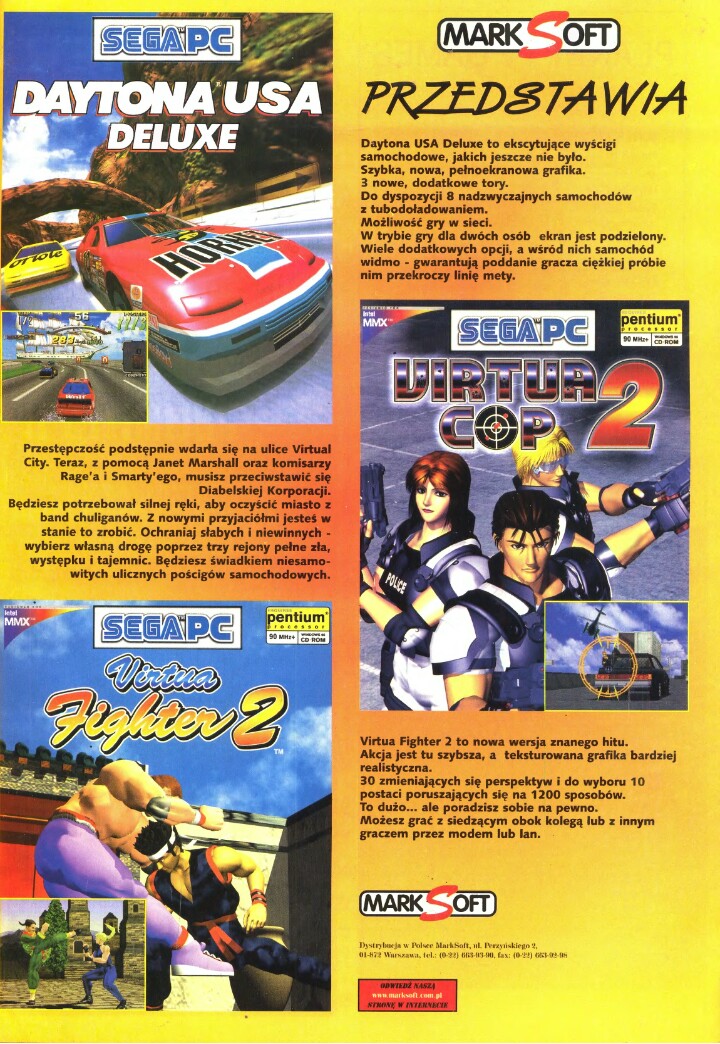Difference between revisions of "History of Sega in Poland"
From Sega Retro
Lukdriver14 (talk | contribs) m (→Lanser) |
Lukdriver14 (talk | contribs) |
||
| Line 39: | Line 39: | ||
}} | }} | ||
{{gitem|Sega Dreamcast advert PL.jpg|Dreamcast advert}} | {{gitem|Sega Dreamcast advert PL.jpg|Dreamcast advert}} | ||
| − | {{gitem|Sega Dreamcast | + | {{gitem|Sega Dreamcast advert 2 PL.jpg|Dreamcast advert 2}} |
== CD Projekt and Cenega == | == CD Projekt and Cenega == | ||
Revision as of 11:40, 7 March 2019

|
| History of Sega in Poland |
|---|
| Official Sega distributor(s): Bobmark International (1994-1997), Lanser (1997-2003), CD Projekt (2003-2014), Cenega (2014-present) |
The fall of communist Poland in the September of 1989 led to the peaceful transition to the Third Polish Republic in the years that followed. No longer under strict political regimes and the wider sphere of influence from the Soviet Union, Poland was able to open its markets in the early 1990s, enabling the country to import luxary items (such as video game consoles) from elsewhere.Until 1994, Sega consoles reached the state only as a gift for children from people working abroad.
Contents
Bobmark
Like many of its contemporaries, Sega did not immediately create distribution channels across the Eastern bloc, so in order to supply video games to the country, local companies were forced to innovate. Bobmark International was among the first companies to enter the Polish market, and in 1992 began distributing Pegasus consoles in the region - a clone of the Nintendo Famicom which also found success across the former Yugoslavian republics around this time.
The Pegasus line would become the dominant console across Poland, however 1994 saw a change in the law preventing Bobmark from selling another unlicensed system. In response, the company acquired an official distribution license from Sega, and in 1994 began marketing Sega products in the country. Bobmark created a new company, trading as AGES ("Sega" reversed) specifically to distribute these systems.
Alongside the model 2 Sega Mega Drive, Ages would attempt to market the model 2 Sega Mega-CD, model 2 Sega Master System and Sega Game Gear in the region. The Polish public were not receptive - no Sega console sold as well as the company had hoped, unlike its Pegasus systems which were far more popular. Bobmark would abandon the Ages moniker and begin trading as itself once more in summer 1995. [1]
In response (and possibly with the blessing of Sega), Bobmark began selling the unlicensed Taiwanese-built KW-501 Mega Drive clone as the Power Pegasus. Released in preparation for Christmas 1995 [2] and hoping to trade off a more successful brand, it too failed to catch on.
On March 1, 1996 Bobmark released the Sega Saturn, however despite its large advertising campaign like 'Win a car with Sega Saturn', the system fell short of expectations. In end of 1997 the company cancelled its distribution agreement[3].
In 1996, TCI's technology group got the rights to distribute the Sega Channel in Poland, but it is not known that the service was launched there.
also published in:
- Secret Service (PL) #38: "Wrzesień 1996" (1996-09-01)[4]
Lanser and Marksoft
In end of 1997 Lanser became Sega distributor and continued sell of Sega Saturn.[5]Since 1998, the sale of Sega PC games has been taken by Marksoft.The first Sega Dreamcast consoles appeared thanks to importers in November 1999 who imported consoles from Western Europe at a price of 1450 PLN. The console was officially released in 2000 with a lower price.
CD Projekt and Cenega
In 2003, CDP became the exclusive distributor of Sega products.[6] The cooperation lasted until 2014 in which the functions of the distributor were taken over by Cenega. This was due to problems in the CDP company.[7]Cenega is still the official representative of Sega in Poland and throughout the Visegrad Group
Sega Mega Drive clones
Many stores started to sell bootleg games knowing that many people have Sega Mega Drive consoles imported from abroad .Games cost less than 50 PLN ($ 15).Before Sega entered Poland, Hegatar Computing started selling the Super Drive console in 1994.[8]The console, however, was not popular and was quickly forgotten.There were many other clones but they were not very popular. Their price was about 300 PLN ($ 80).[9]
- Power Pegasus + Spirou.jpg
Power Pegasus + Spirou offered as a prize in one of the programs. Founded by Hoop-subsidiary of Bobmark
Magic Play
Nowadays, Sega arcades are distributed by Magic Play.[10]
References
- ↑ File:TopSecret PL 41.pdf, page 59
- ↑ File:TopSecret 38 PL Play Box 95.jpg
- ↑ http://www.strefapsx.pl/ceny-konsol-w-polsce-w-latach-1996-2006/
- ↑ Secret Service, "Wrzesień 1996" (PL; 1996-09-01), page 75
- ↑ File:SecretService_PL_51.pdf, page 74
- ↑ https://www.gry-online.pl/S013.asp?ID=8606
- ↑ http://www.komputerswiat.pl/gamezilla/newsy/2014/13/cd-projekt-po-cichu-stracil-sege
- ↑ Gry Komputerowe 4/1994 page 12
- ↑ PSX Extreme 247
- ↑ https://magicplay.eu/?en_about-us,3




